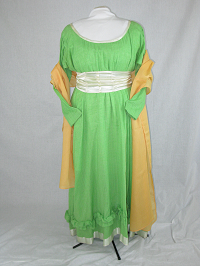1795-1800
By the end of the 18th century, the upheavals of the French Revolution reached the field of dress. The cumbersome gowns, hoops, and petticoats were discarded. The new French Republic sparked an interest in classical Greece and the natural figure was uncovered. A favorite of the Directorate was said to have a figure that should not be hidden and she didn't! Soft material such as sheer muslins showed every contour and left nothing to the imagination. Material also became cheaper as New England became the textile capital of United States. Personal wardrobes expanded to include outfits for particular times of the day as well as for special activities.
This simple gown could be made by almost anyone. It did not require a pattern like the tightly fitted dresses of the previous era. A revolution is a breaking out or loosening of bonds. In the fashion at the beginning of the 19th century we see the restricting stays (or corset) disappear. A new freedom for the body, which had long been confined in metal, bones and cloth, developed. Corsets of the 18th century molded a woman's body by forcing the shoulder blades together to give the proper posture. When this restriction was removed the back slowly returned to normal. Wigs were also discarded, and hair was cropped short and covered. Turbans, probably reintroduced by Napoleon's travels, appear as part of the female attire. The three ostrich plumes help date this outfit to just about 1800 as flowers were used after that date. The hem and neckline are trimmed to match the satin bow.
Click photo for detailed views.


